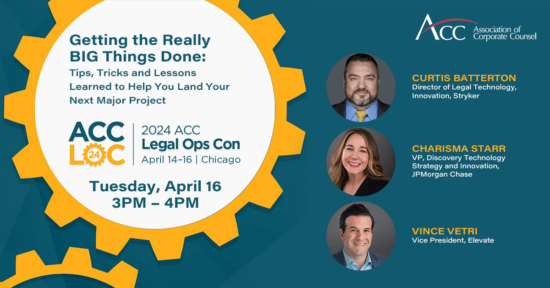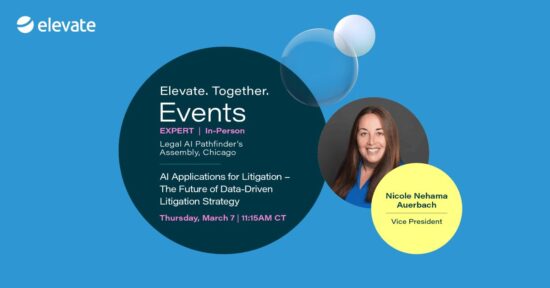Step Changes for Law Departments: Achieving Quantum Leaps (ACC Legal Ops Con 2024)
April 10, 2024
Consulting elm law department consulting legal operations law department
Uneasy has become pervasive in law departments, and heading into this year’s ACC Legal Ops Con (April 14 through 16 in Chicago), we and our Elevate colleagues consistently hear the same questions in conversations with law department leaders and legal ops teams:
- How do we contend with unpredictable and rapidly evolving legal and business priorities?
- What approaches will quickly grow our ROI by leaps and bounds, not small increments?
- Where should we be using AI? (My boss is asking me! 😊)
Legal teams need quantum leaps forward, not incremental improvements
A paradox is driving these questions: law departments are wedded to the marginal gain strategy of improvement but must increase value-add faster than the growth (if any) in their budgets, headcounts, or time available for work.
No wonder unprecedented levels of lawyer fatigue are now prevalent: regulatory challenges (for example, privacy and data breach notification requirements) continue to pile up, requests for faster and clearer guidance (e.g., policies covering the use of and reliance on generative AI) keep coming, and the risks to productivity and potential for delays keep rising. And did we mention the emerging demands on GCs and their law departments to deliver business value?
Simply put, legal teams are tired from (and with) initiatives that yield only modest gains. They need ‘big wins.’ However, for law departments that seek to ‘bend the curve’ and markedly boost their value add, tinkering will not succeed. They must instead engage in radical thinking – so-called step change – and overhauling processes.
That makes ACC Legal Ops Con especially timely. For in-house counsel seeking to optimise their department’s legal operations, the conference is a unique and curated opportunity for in-house colleagues and experts in the legal operations community to collaborate, share knowledge, and participate in no-nonsense discussions about impactful approaches to legal ops.
What constitutes step change for law departments? Answering that question begins with considering what law departments have done to leap ahead. We rallied our Elevate colleagues to survey the landscape, and they identified five step-change initiatives implemented by Elevate customers that have driven significant ROI for legal and the business:
The Critical First Step: Intelligent Request Management
Smart request management is an indispensable catalyst for innovation.
For legal teams and leaders, business enablement requires breaking free from endless requests and overflowing inboxes. At work and beyond it, many of us have embraced software to streamline routine tasks. Yet, for core Legal workflows, request intake and routing, email rules. This ensures teams remain stuck in reactive mode. And proactive strategic planning falls by the wayside. People are either too busy to think about making improvements or leave it to that mythical moment of ‘once I’m through my to-do list’.
Purpose-built request management software provides a central intake funnel to capture and automatically triage incoming asks. Not only do you gain efficiency, you’re unlocking insights. By consolidating request data, Legal Ops obtains visibility into demand patterns, bottlenecks, and areas ripe for optimisation.
There is no shortage of products (such as Mitratech TAP, ServiceNow Legal Service Delivery, Elevate ELM, and many others) to manage legal matter requests. The tool you choose should be ‘platform agnostic,’ compatible with all of your other systems, and provide the law department with the ability to, at a minimum, track and report on incoming demand for law department assistance.
Charting the Course for Step Change: Identifying the Most Valuable North Stars
Achieving step change demands total spend visibility, value alignment, and an optimisation roadmap.
For the GC and Legal Operations leader, two beacons shine brightest – ensuring legal spend aligns with business growth, and minimising risk.
While most legal teams excel at winning large and important matters, few feel they can confidently map out their overall legal spend composition and pinpoint areas of misalignment. It does not solve the objective to simply cut spend. Step change means optimising spend to fuel capabilities that mitigate risks effectively and propel business growth.
To chart a clear trajectory, legal teams must:
1) Gain Total Spend Visibility: Understand exactly where and how the entire legal budget flows, beyond just total internal and external numbers. Granular insight into spend by matter type, vendor, practice area, and business unit illuminates previously obscured terrain.
2) Conduct Core vs. Context Effort and Spend Analysis: Overlay spend data with a strong understanding of what’s Core (mission critical and directly aligned to business risk or growth) versus Context (non-mission critical, ‘run-the-company’) to your business.
How much time or money are you spending on core activities? Context activities? And is that ratio the right one?
With this clarity, you can quickly identify gaps where you may be overspending on context work or underfunding core, mission critical areas. Misalignment anywhere on this map constitutes ‘working harder, not smarter.’ Fixing that alignment not only produces happier teams and internal customers but also more value for your money.
3) Develop an Optimisation Roadmap: Identify two to three things the law department will do over the next 18 months to clean and repurpose waste and further maximise the value of the total legal spend for the company. This will ensure more value for each dollar spent rather than trying to simply reduce spend. This may include right-sourcing context work or investing in legal experience to help the company avoid risks and grow quickly.
Industry resources such as the free Legal Spend Management Primer (published in collaboration with Buying Legal Council) provide further tools to get started.
Centralise Context Legal Work to Global Legal Support Teams (LSTs)
Lawyers are buried in routine work. Repoint your most valuable resources to activities that fuel business growth.
Lawyers are buried in context and routine legal work. Not only can end up costing the company a lot of money (e.g., in instances when lawyer compensation is inversely proportional to value delivered), it also can erode productivity (tired lawyers!). The solution? Align experienced lawyers’ activities with the business’s need for strategic advice and counsel, and leave the routine activities to readily available, tech-powered resources that are more cost-effective.
Getting your lawyers onboard is easy – they are already eager to swap routine, run-the-business work for activities that generate maximum value for the business. But where do you begin? What exactly falls into each category of context or routine legal work? As explained in this recent article, the work in question is low in complexity, high in volume, routine, and tied to a business’s day-to-day operations.
Having identified the type of work involved, begin working with your legal operations team to stand up a legal support team (LST) designed to help your lawyers identify, transition and stabilise these activities from lawyers to the LST. The LST should be led by a known and trusted in-house individual and powered and supported by one (or multiple) law companies who can provide cost-effective and global resourcing and Software at scale.
Turbo-Power Your Contracting Engine with Speed and Efficiency
Rebranding the law department from deal-killer to deal-enabler.
Transforming your law department to better enable the business means shift from a ‘don’t’ mentality to a ‘here’s how’ ones, whereby helping the business close deals (either via sales or in purchasing) is the law department’s focus.
But before you rush out to buy a CLM, (which is oftentimes heavy and expensive), focus on streamlining overall contracts operations. Remember: contracts-related technology cannot generate a better contracts process – it can only power one. When it comes to contracting processes and CLMs, you must ‘optimise before you buy.’ For example, your lawyers don’t need to scrutinise every single contract; colleagues outside the law department can handle routine agreements using standard templates and a set of criteria for when to (and when not to) use them.
Turbo-powering your company’s contracting involves:
- Stratifying contracts into proper categories of complexity
- Clarifying the appropriate lines of authority between the business and legal
- Ensuring context (higher volume, repeat, lower risk) agreements have proper templates and playbooks in place for self-service for the business (within reasonable policies) or managed service providers to support in cost -effective fashion
- Limiting the number of handoffs needed to get a contract approved and signed
- Implementing a company-wide, consistent approach to the intake, review and status updates of agreements escalated to law department review
Only once you have completed those steps are you ready for a CLM. Meanwhile, your streamlined process will deliver real saving that can quickly add up to millions of dollars. (More insight into the topic is available here.)
Further Elevate Your Litigation Support and Technology using AI
The combination of experts and AI, deployed in the right way, can provide competitive advantage in litigation.
Litigation continues to be a high spend, high impact category for most law departments. This means it is ripe for continuous improvement. Innovation in this area is far from over – in fact, it’s just begun. Most organisations have taken initial steps to lower the cost of eDiscovery and review, but many of those innovative initiatives are rapidly approaching the 10-year mark. A decade is ages in eDiscovery innovation, and the time is ripe to reevaluate at where and how to further optimise these programs (including through the steps outlined here).
AI has begun to make significant inroads in litigation and is now providing litigators and their support teams previously unattainable benefits, including ones that give parties a competitive advantage in legal disputes. Examples abound: Casetext’s use of AI for discovery response and Cloud Court’s Gibson for the review and use of testimony. These accelerate matter resolution, sharply lower overall litigation spend.
Leveraging AI can be as simple as updating outside counsel guidelines to incentise the use of these types of tools. In the near-term, firms that embrace AI will enjoy a significant competitive advantage. And, when AI-powered litigation capabilities become table-stakes, they will already have them.
Which step change initiatives have you peppered into your marginal gain strategy to produce leap results? If you are at ACC Legal Ops Con, we’d love to chat about this – to learn how you are implementing step change in your organisation. We’re on a mission to transform the industry and it all starts with collaboration – so what better place to start than ACC Legal Ops Con 2024?
And, if your ACC Legal Ops schedule permits, please come join us on Tuesday, April 16 at 3:00 pm, where Elevate Expert and Vice President Vince Vetri will lead the panel ‘Getting the Really BIG Things Done: Tips, Tricks and Lessons Learned to Help You Land Your Next Major Project’. Joining Vince in this hour-long session will be Curtis Batterton, Director of Legal Technology, Innovation at Stryker and Charisma Starr, VP – Discovery Technology Strategy and Innovation at JPMorgan Chase. The panel is a chance to hear how your law department peers have gotten comfortable with step-change to achieve major change and succeed at crossing the chasm into big-ticket success.
Back to Expertise









